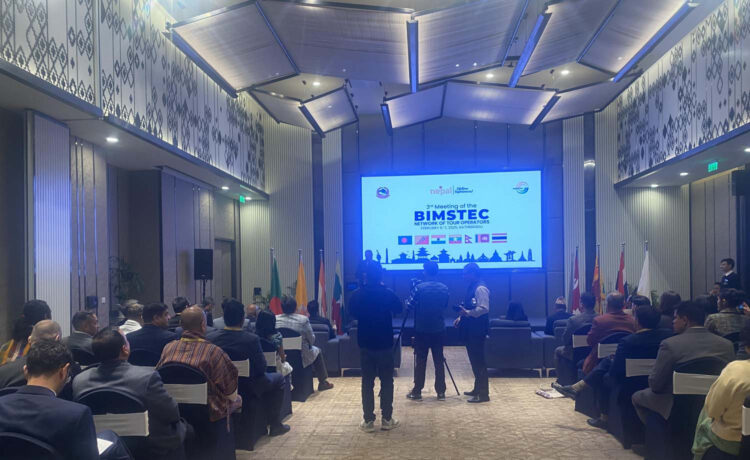China continues to ease its visa policies to enhance openness and promote people-to-people exchanges, allowing more foreign travellers and business professionals to visit the country visa-free.
Recent data confirms that the relaxation of visa policies has delivered visible results.
Considerable investments in the sector have helped Saudi Arabia become a tourism mecca. The UAE and Qatar emerged as dominant Middle East tourism markets.
As of early 2025, tourism is experiencing heightened competition driven by several key factors. This growing demand intensifies competition among destinations and service providers aiming to attract these travellers.
The competition is heated in Southeast Asian nations as well to increase the numbers as travellers are increasingly seeking unique experiences, such as wellness retreats, eco-tourism, and cultural immersions, which these nations have in abundance.
But there is still some red tape.
On Thursday, the Bimstec (Bay of Bengal Initiative for Multi-Sectoral Technical and Economic Cooperation) network of tour operators—an international organisation comprising seven South Asian and Southeast Asian nations with a combined population of 1.73 billion—held its third meeting in Kathmandu.
The meeting focused on initiatives to boost regional tourism for shared prosperity—by removing the red tape.
After seven years, this in-person meeting is expected to address several bureaucratic hurdles, particularly in visa processing, currency exchange, and connectivity, which have made travel difficult despite geographical proximity.
Nepal’s Tourism Secretary Binod Prakash Singh said, “Each nation has unique tourism strengths and challenges. By learning from each other, we can develop more effective tourism strategies.”
He highlighted two key projects with immense potential: the Bimstec Buddhist Circuit and the Bimstec Cruise Circuit.
“Nepal is honoured to be part of the Buddhist Circuit as the birthplace of Lord Buddha. Lumbini is not just a pilgrimage site but a global symbol of peace and enlightenment. We are committed to improving connectivity and infrastructure to ensure seamless travel for pilgrims and tourists.”
He added, “This initiative will allow travellers to explore the region’s maritime heritage and enhance intra-regional connectivity.”
“One of the most significant barriers to regional tourism is visa restrictions. Nepal has taken steps to simplify visa processes through e-visas and visa-on-arrival facilities, but we need a collective effort to facilitate smoother travel across Bimstec countries.
“A regional visa-free arrangement or a streamlined visa system would significantly boost tourist arrivals and encourage cultural exchange.”
He said the region must focus on joint marketing strategies to promote intra-regional tourism.
“Imagine a seamless journey where a tourist can experience Nepal’s majestic Himalayas, Thailand’s stunning beaches, India’s rich cultural heritage, Bhutan’s sacred monasteries, Sri Lanka’s vibrant wildlife, Bangladesh’s Sundarbans, and Myanmar’s ancient temples—all within a single itinerary. By working together, we can create attractive travel packages that showcase the diversity of our region,” he said.
Another crucial issue discussed was currency exchange.
“If Bimstec countries adopt easier currency conversion mechanisms, it will greatly improve travel convenience and economic cooperation. I hope this forum can facilitate discussions on this matter.”
Deepak Raj Joshi, CEO of Nepal Tourism Board, said as members of Bimstec, “we share a common vision of regional prosperity, and tourism is one of the strongest pillars that can drive us forward together”.
The meeting discussed key agenda items, such as promoting Buddhist Circuits, easing visa formalities and cross-border travel, and creating a dedicated Bimstec Tourism Mart.
“These discussions will help us identify gaps and explore solutions that bring mutual benefits to the region,” said Joshi.
Buddhism is a shared heritage across the Bimstec region, offering immense potential for spiritual and cultural tourism.
“As Lord Buddha’s birthplace, Nepal must be positioned as the gateway to the Buddhist Circuit, as many travellers would love to start their pilgrimage from Lumbini. Integrating sacred sites across Bimstec nations can create a seamless and enriching experience for Buddhist pilgrims while boosting regional tourism.”
Connectivity is the backbone of tourism. “To enhance intra-regional travel, we must prioritise simplifying visa processes, streamlining border crossings, and improving infrastructure,” he said.
“Additionally, easing currency convertibility is equally crucial for hassle-free travel. Moving towards a more integrated Bimstec travel network, we should explore solutions such as multiple-entry regional visas, digital travel permits, and improved border facilitation to make cross-border tourism seamless.”
The outbound market within Bimstec is nearly 45 million travellers, yet intra-regional travel is still below its true potential.
Joshi said that post-Covid, over 20 new five-star hotels have opened in Nepal, and many are opening soon, with many international hotel chains investing in Nepal.
“This is a testament to Nepal’s growing strength as a leading tourism destination in the region.”
Si Thu Aung, director of the people-to-people contact sector at the Bimstec Secretariat, said collaborating in tourism will enable us to harness the untapped potential within the Bimstec region. It will also foster synergies and establish long-term partnerships for regional tourism development.
“We can benefit from the experience of our member states in attracting more tourists and developing their tourism sector.”
He said that the Kathmandu meeting is particularly significant for several reasons.
“First, the meeting will deliberate on the critical issue of operationalisation of Bimstec Buddhist Circuits and Bimstec Cruise Circuits. The ideas and suggestions of the meeting will define the products, norms and standards, logistics coordination, and other aspects of joint marketing and promotion, as well as overall management, in finalising these modalities.”
Second, according to him, the meeting’s focus on improving destination management is timely and essential. “Effective management and presentation of destinations are fundamental to attracting tourists and enhancing tourism’s contribution to local economies.”
“Third, the meeting also provides recommendations regarding visa facilitation measures in promoting regional tourism, which is an important aspect of promoting tourism,” he said.
He said the outcomes would be considered by the Expert Group on Visa Matters, which is working on the Bimstec Visa Facilitation Scheme, which will cover various categories of visas, including tourist visas.
“The recommendations emerging from today’s discussions will also contribute to implementing the updated Tourism Plan of Action and pave the way for deepened cooperation in the tourism sector between the member states,” he said.

